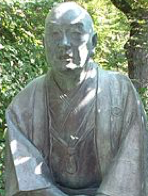 Ihara Saikaku was a 17th century Japanese haikai poet who has also been credited with the creation of the so-called “floating world” genre of prose which was, effectively, the earliest known Japanese fiction.
Ihara Saikaku was a 17th century Japanese haikai poet who has also been credited with the creation of the so-called “floating world” genre of prose which was, effectively, the earliest known Japanese fiction.
He was born Hirayama Togo in Osaka sometime during the year 1642, the son of a wealthy merchant of that city. With ambitions to become a writer he was initially a student of haikai poetry under a tutor named Matsunaga Teitoku, subsequently taking up a place at the Danrin School of poetry. It seems that he was an extraordinarily talented student in this discipline, becoming a haikai master by the age of 20. He quickly became well established in Japanese literary circles although, in his early years, he used the pen name Ihara Kakuei.
He imposed his own style on the haikai genre of poetry and, coming from a merchant background, it was inevitable that he would write about that aspect of life, often referred to as the “chonin” life of the city. He used colloquial language to make his verse more accessible. By 1673 he decided to start using his own name but a tragic event was soon to follow, sparking a mammoth writing exercise. His beloved wife died in 1675 and, in his grief, he composed a haikai poem of over a thousand verses to honour her. This was achieved in a period of approximately 12 hours. He called it Haikai Single Day Thousand Verse and it is believed that this achievement led to Saikaku deciding to write novels.
At first he decided to travel throughout Japan as a lay monk, even though it meant leaving his children behind to be cared for by other members of his family. He was back in Osaka by 1677 and sometime during that year he exceeded his previous gargantuan writing effort by some margin. His thousand-verse poem had been well received and it was reported that, during one single day and night session, he composed somewhere between 16,000 and 24,000 haikai stanzas.
Saikaku then decided that he had the talent and means to become a professional writer. He stuck to haikai poetry at first but, in 1682, his first novel appeared under the title The Life of an Amorous Man. A later title, of a similar nature, was The Life of an Amorous Woman and was another of the author’s racy, often erotic, accounts of the lives of the merchant classes in 17th century Japan. His literary output was considerable and he certainly became one of the most popular writers at this time when the country was under the rule of the Tokugawa Shogunate.
Existing evidence of his poetry is limited and here is one very short and curious example. It is a three-line poem called A Sake Barrel:

History has placed Saikaku in the genre of writers more famous for their fiction rather than as poets, despite his considerable early efforts in haikai. His work can never be called “high” literature but, nevertheless, his name as a purveyor of tales of the so-called “demimonde” (people who led hedonistic lifestyles) has stood the test of time.
Ihara Saikaku died on the 9th September 1693 at the age of 51.

